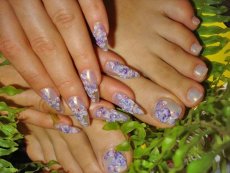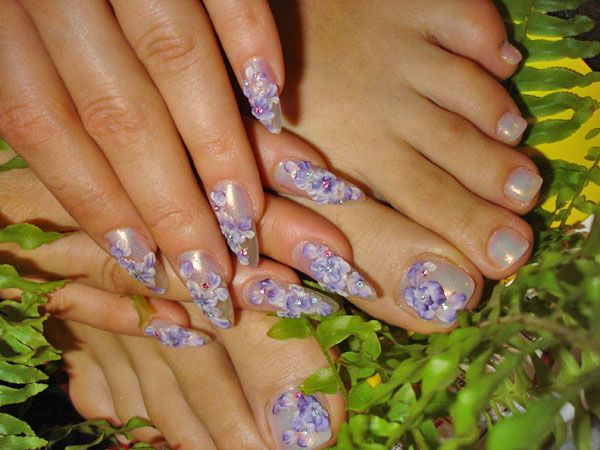Medical expert of the article
New publications
How to do a pedicure properly
Last reviewed: 04.07.2025

All iLive content is medically reviewed or fact checked to ensure as much factual accuracy as possible.
We have strict sourcing guidelines and only link to reputable media sites, academic research institutions and, whenever possible, medically peer reviewed studies. Note that the numbers in parentheses ([1], [2], etc.) are clickable links to these studies.
If you feel that any of our content is inaccurate, out-of-date, or otherwise questionable, please select it and press Ctrl + Enter.

Just like fingernails, toenails also need to be taken care of. Pedicure comes from the Latin words "pedis" and "cura". The word pedis means "feet" and "cura" means help, care, that is, "help to the feet" or care for the feet. Pedicure can be defined as a process that improves the appearance of the feet and nails. How to do a pedicure at home and how to protect yourself from infections in a spa?
What is the essence of a pedicure
Pedicure and manicure are similar services, the only difference between them is that manicure is a process of hand care, and pedicure is for feet. Pedicure helps protect toenails from fungal diseases and makes them beautiful and attractive. It also helps remove dead cells from the skin with the help of pumice (rough stone) rubbed on the feet. Pedicure also includes visiting establishments that provide these services.
Pedicure includes such additional services as epilation either by waxing or shaving the legs, it can also include peeling, foot massage and moisturizing. Anyone suffering from blood clots on the legs, in addition to a pedicure, can also get a foot massage for the beauty of their legs.
Just as you care for your hands and nails, so should you care for your feet and toenails.
Pedicure at home
You can do your own pedicure at home. Follow these steps to do a pedicure at home.
What you need for a pedicure at home
- Pumice
- Nail file
- Manicure nippers
- Moisturizing cream
- Base coat
- Cuticle pusher (special small tool)
- A container, basin or bucket large enough for a pedicure
What should be done?
Remove old nail polish completely. Use cotton swabs to create spaces between your toes by inserting the swabs into the spaces.
Remove the old nail polish to make room for the new one. If the polish doesn't come off, apply pads of nail polish remover and let it sit for a while to loosen the layer of polish.
How to properly cut nails during a pedicure?
First of all, you need to use high-quality scissors to cut your toenails well. You need to cut your nails straight across, leaving about 1/8 of their length. Do not let the tips of your toenails go past the ends of your toes. For a soft square nail shape, file them at the corners in one direction.
Use a glass file rather than a metal one, as a metal file will damage your nails. The smoother the surface for smoothing the edge of your nails, the better, as a rough nail surface is much more difficult to work with.
Get a large, flat-bottomed water container. Add bath salts, aromatherapy oils, or Epsom salts and let your feet soak for a few minutes. The more calluses you have on your feet, the longer you should soak them. Add about a quarter cup of milk to the warm water.
The lactic acid in milk will help slough off dead skin from your feet.
Push back the cuticle at the base of each toenail. Wait a minute, then use a cuticle pusher to push back the remaining cuticle.
Use nail scissors to trim loose cuticle skin. Do not cut it, as this will slow down nail growth.
Use a foot scrub or exfoliant, then use a pumice stone to remove dead skin cells. The idea is to smooth your heels, not rub them raw. If your heel turns bright red, stop. That means you're using a pumice stone that's too hard.
Dry your feet thoroughly, including between your toes, and apply a nourishing foot cream.
Moisturize the cuticle with a special cuticle oil.
Use a special product to get rid of excess oil on your nails.
Apply a thin coat of polish using three strokes, one in the middle and one on each side. Do not paint the cuticles with polish. A proper pedicure uses three coats of polish, then apply a thin base coat. Use a safe nail polish remover to remove excess polish from your nails.
Let your nails dry completely before you put on shoes.
Useful tips for pedicure

- If you want to let the polish dry completely, do not wear your shoes for at least two and a half hours.
- Never cut dead skin cells from your toes using tweezers or scissors, as this can injure the delicate skin of your feet. Instead, use a pumice stone or a rough washcloth.
- Keep your feet clean at all times to avoid fungal infections.
- Always try to keep your feet dry, even between your toes.
- Remove cuticles regularly. On average, twice a week.
Safe pedicure in a spa salon
You've been on your feet all day and you're starting to dream of a nice pedicure. How wonderful it would be to get away from the hustle and bustle and pamper your feet. But it could cost you some unpleasant health consequences. Did you know that you could get a fungal infection along with your pedicure! An open wound can become infected with an infection that lives in public locker rooms, saunas or hot tubs.
Before you choose a good salon for a pedicure, think again. You are taking the risk of getting a foot infection in almost any salon. Here are some helpful tips to keep your nails healthy.
Ask your pedicurist questions. Have you ever asked pedicurists how they disinfect their tools?
Look at the spa tools. Are they stainless steel? Are they sanitized between clients? Never be shy about asking these questions. Some salons may not give you the answers you want.
Disinfection of instruments in a spa salon is the most important point of a pedicure.
The only way to be sure that there are no more bacteria or fungi on your instruments is to use an autoclave to disinfect them. An autoclave properly disinfects the instrument at a high enough temperature and for a sufficient amount of time.
An easy way to avoid getting infected at a spa is to use your own set of tools. This will ensure that your toenails don't pick up your neighbor's fungus from the shared pedicure tools.
Many spa tools are made of fiberglass, which is very difficult to clean properly without damaging it. This leads to constant contamination.
Before you sit in the chair, you should make sure that the tools look perfect and that they have been disinfected. For a perfect pedicure, the tools should be stainless steel, which is much easier to clean than fiberglass.
Avoid false nails, which are a haven for bacteria and fungi.
The fact that the skin under the nails turns green and yellow may be the work of bacteria leading to infection.
Your cuticles need to be protected for their natural defense system against infections. Make sure that the technician does not cut your cuticles too much, so that bacteria do not enter the open wounds.
Nail polish can be a trap for bacteria, but more importantly, you may not be able to notice changes underneath your nails due to poor quality polish.
Changes in the natural color of the nail or nail bed are signs of infection that should be addressed immediately. If you can't resist fungi, try antibacterial nail polish. Many salon professionals offer this type of nail polish for toenails.
Podiatrists (nail health specialists) can advise you on proper pedicures. They are very knowledgeable about the risks associated with pedicures and can recommend spas and techniques that will keep you safe.
How to Avoid Getting Fungus During a Pedicure
If you get regular pedicures, bring your own tools or go to a spa that autoclaves their tools.
Clean your nails with rubbing alcohol before using them if you are cutting your nails, and make sure your tools are disinfected regularly.
We also recommend that you clean your shoes regularly, either with an antibacterial spray, or better yet, an antibacterial and antifungal spray, and dry them with a hair dryer at least once a month to remove moisture.
Keep your feet dry and clean. Change your socks regularly (even several times a day if your feet sweat often).
Sports shoes should be dry, change them regularly. If you regularly exercise, buy sports shoes one and a half sizes larger than your everyday shoes.
Useful facts from the history of pedicure
People have been trusting pedicures with their nails for over 4,000 years. In southern Babylonia, nobles used instruments made of pure gold to provide themselves with manicures and pedicures. The history of nail polish can be traced back even further. In China in 3000 BC, nail color indicated social status, according to Ming Dynasty manuscripts. Egyptians had their nails painted black and red. Ancient Egyptians were using manicures and pedicures as early as 2300 BC.
Depictions of manicures and pedicures have been found on carvings from a pharaoh’s tomb, and scholars have long known that Egyptians paid special attention to their hands and feet. Egyptians also colored their nails, using red to indicate high social status. A manuscript says that Cleopatra’s nails were painted a deep red, while Queen Nefertiti’s were painted a vibrant ruby red. In ancient Egypt and Rome, military commanders also painted their nails red to match their lips before they went into battle.
Although modern toenail design only appeared in the late 19th century, the nail file as a nail care tool has been around for a long time. Marie Antoinette was famous for her obsession with a nail file made from pumice. Her perfectly shaped nails made her the most fashionable and beautiful woman in the French Versailles. Her pumice stone was carved into a shape that is used to trim and shape the edge of the nail. This tool was not destroyed after use, it was washed and disinfected by the maids, placing it in the bathroom. So that the file could be used again.
Pedicure in winter
Even if your feet aren't visible to others during the winter, you should continue to get pedicures on a regular basis. Pedicures don't just help you show off your pretty toes, they can also help keep your skin and joints healthy. If you enjoy regular pedicures during the summer months, you probably already know the benefits.
Every pedicure begins with a foot spa treatment, which is designed to soften the skin and make manipulation easier. A foot spa is a stimulation of blood circulation through the shins and ankles, which can reduce any pain and swelling you may have from standing or sitting throughout the day. Softening the skin on your feet can also reduce the formation of calluses and corns, which can be very painful, especially when wearing heavy winter boots.
Your nails need regular attention during the winter months. You may not realize it, but cold weather can act as a drying agent for your skin and nails. Dry, brittle nails are prone to splitting and breaking, which can be painful but can also lead to infection. Regular pedicures from the best nail salons can ensure that your nails are healthy and reduce the chances of ingrown nails or painful splitting.
Finally, the nail salon offers a massage with every pedicure, which can further help improve blood circulation in the legs and feet. This can loosen tight muscles and strengthen them, which is especially effective in cold weather to eliminate joint and muscle pain.

